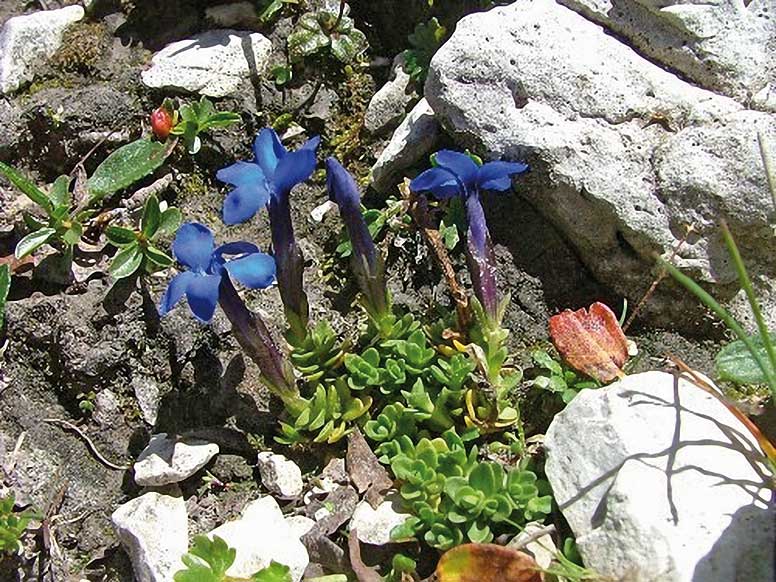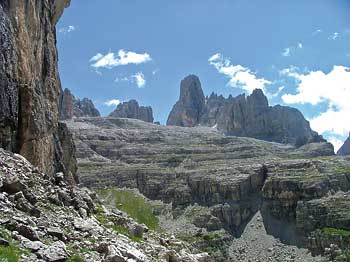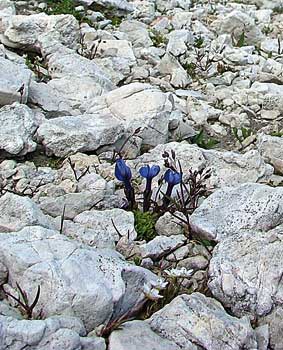| |

THE GENTIAN PLANT OF BRENTA
Carlo Signorini
 A ccustomed as we are to hearing alarming news about the wholly unnatural extinctions that occur on a daily basis on the planet Earth, it is difficult to conceive that a new flower has been classified within a context that is so characterised by environmental pollution. The location of this fantastic discovery would have to be none other than the much-loved Dolomites, and more precisely, the Brenta mountain range. It is a small and simple gentian, with a shy and somewhat unremarkable appearance; who knows how many times our distracted walking shoe has trodden on it. Despite this, its discovery is a great event on a worldwide scale.The gentian family includes a vast group of plants, with quite varied appearances: ranging from plants with quite a high build to miniature little plants. The colours of their flowers are also quite varied and they range from yellowish green to intense and sometimes spotted yellow; also intense blue, which flows into purple and almost pink. Some gentian plants have excellent curing properties for the many disturbances of the gastric apparatus, flatulence, intestinal atony, complications with the hepatic apparatus and all digestive malfunctions, they act as a general tonic, they stimulate the appetite, they are febrifugal, and purifying. Amongst these there is the Gentiana lutea (or main Gentian), well known alpine prairie plant found all over the Dolomites. Its curing, medicinal properties were already well known since ancient times.Dosage: ½ a teaspoon of dried and ground root for each cup of hot water, leave to infuse with a cover for 15 minutes, to be sipped throughout the day. Be warned that the flavour is quite bitter. Apart from physical aspects, every being in nature also has characteristics that are not material; I will now try to describe such aspects of this type of plant. I consider the medicinal gentian plants to be angels that come to our aid A ccustomed as we are to hearing alarming news about the wholly unnatural extinctions that occur on a daily basis on the planet Earth, it is difficult to conceive that a new flower has been classified within a context that is so characterised by environmental pollution. The location of this fantastic discovery would have to be none other than the much-loved Dolomites, and more precisely, the Brenta mountain range. It is a small and simple gentian, with a shy and somewhat unremarkable appearance; who knows how many times our distracted walking shoe has trodden on it. Despite this, its discovery is a great event on a worldwide scale.The gentian family includes a vast group of plants, with quite varied appearances: ranging from plants with quite a high build to miniature little plants. The colours of their flowers are also quite varied and they range from yellowish green to intense and sometimes spotted yellow; also intense blue, which flows into purple and almost pink. Some gentian plants have excellent curing properties for the many disturbances of the gastric apparatus, flatulence, intestinal atony, complications with the hepatic apparatus and all digestive malfunctions, they act as a general tonic, they stimulate the appetite, they are febrifugal, and purifying. Amongst these there is the Gentiana lutea (or main Gentian), well known alpine prairie plant found all over the Dolomites. Its curing, medicinal properties were already well known since ancient times.Dosage: ½ a teaspoon of dried and ground root for each cup of hot water, leave to infuse with a cover for 15 minutes, to be sipped throughout the day. Be warned that the flavour is quite bitter. Apart from physical aspects, every being in nature also has characteristics that are not material; I will now try to describe such aspects of this type of plant. I consider the medicinal gentian plants to be angels that come to our aid when we accumulate tension and blockages in our sub-conscious that are not accepted by our deep conscience. In the long term, this tension accumulates, causing friction that can easily degenerate into veritable illnesses, that may be very serious and that may also lead to very intense depression.In such cases, Gentian can help us to heal, but it cannot do so not alone, only if we really want to, by becoming aware of the fact that we are never alone and that there are forces around us that are ready to help us. In this case, acquiring awareness is the true medicine rather than the plant, the plant becomes a means by which to facilitate such a passage. It is not at all easy to interpret this, it sometimes means completely overturning the meaning that we have given to Existence.The parts of the gentian that are most commonly used are the roots, parts of the plant that are not visible, where energy is accumulated over time, which will then be used to facilitate the melting of tensions positioned in the depths of our subconscious.Gentian plants with yellow flowers mostly help in situations where there is a lack of personal balance, accompanied by mistrust of oneself and others.Those with blue coloured flowers help us to release traumas that prevent the flow of our ability to express ourselves and our creativity.The bitter taste symbolises the bitter taste of ancient friction that has accumulated over time in the bottom of our deep Well. We need to be tenacious and when we accumulate tension and blockages in our sub-conscious that are not accepted by our deep conscience. In the long term, this tension accumulates, causing friction that can easily degenerate into veritable illnesses, that may be very serious and that may also lead to very intense depression.In such cases, Gentian can help us to heal, but it cannot do so not alone, only if we really want to, by becoming aware of the fact that we are never alone and that there are forces around us that are ready to help us. In this case, acquiring awareness is the true medicine rather than the plant, the plant becomes a means by which to facilitate such a passage. It is not at all easy to interpret this, it sometimes means completely overturning the meaning that we have given to Existence.The parts of the gentian that are most commonly used are the roots, parts of the plant that are not visible, where energy is accumulated over time, which will then be used to facilitate the melting of tensions positioned in the depths of our subconscious.Gentian plants with yellow flowers mostly help in situations where there is a lack of personal balance, accompanied by mistrust of oneself and others.Those with blue coloured flowers help us to release traumas that prevent the flow of our ability to express ourselves and our creativity.The bitter taste symbolises the bitter taste of ancient friction that has accumulated over time in the bottom of our deep Well. We need to be tenacious and  constant in order to scrape out the bottom of it. Perhaps through this gift, the Great Mother has invited our Conscience to open up towards a different comprehension of Creation and its tendency towards Unity with everything; so as not to forget what Universe means: Towards One.In its language it wants to tell us that by living in a detached and unbalanced manner, we inexorably arrive at Suffering. It becomes a clear invitation for us to learn, as soon as possible, to rejoice in the space of the planet Earth and to share it fraternally with the other beings that inhabit it with us. With our inconsiderate behaviour, we give up on the extraordinarily divine abilities that we are already in possession of, that allow us to fulfil the main aim of our existence, both as individuals and as the human race.This is our duty and a small flower cannot fulfil it, the new bud is not only a new scientific discovery, it is also a language with which our Mother lovingly speaks to us. The Dolomites enclose ancient legends that hand us down noble universal values. Stories that are associated with Magic and the Extraordinary, that we often ridicule or at least fail to deeply consider. Perhaps this is an excuse to avoid stopping for a moment, taken as we are by our frenetic race towards littleness. The Magic of a contemporary discovery might slow us down a little, so as to allow that child that lies within each of us to express itself, to melt (at least partially) those old tensions that make our existential pathway quite burdensome. constant in order to scrape out the bottom of it. Perhaps through this gift, the Great Mother has invited our Conscience to open up towards a different comprehension of Creation and its tendency towards Unity with everything; so as not to forget what Universe means: Towards One.In its language it wants to tell us that by living in a detached and unbalanced manner, we inexorably arrive at Suffering. It becomes a clear invitation for us to learn, as soon as possible, to rejoice in the space of the planet Earth and to share it fraternally with the other beings that inhabit it with us. With our inconsiderate behaviour, we give up on the extraordinarily divine abilities that we are already in possession of, that allow us to fulfil the main aim of our existence, both as individuals and as the human race.This is our duty and a small flower cannot fulfil it, the new bud is not only a new scientific discovery, it is also a language with which our Mother lovingly speaks to us. The Dolomites enclose ancient legends that hand us down noble universal values. Stories that are associated with Magic and the Extraordinary, that we often ridicule or at least fail to deeply consider. Perhaps this is an excuse to avoid stopping for a moment, taken as we are by our frenetic race towards littleness. The Magic of a contemporary discovery might slow us down a little, so as to allow that child that lies within each of us to express itself, to melt (at least partially) those old tensions that make our existential pathway quite burdensome.
*** Be careful not to confuse the sterile Gentiana lutea plants with poisonous and potentially fatal Veratrum album plants.
The Gentian Plant of Brenta
During the assessments carried out on the plant life of the Adamello-Brenta Park, the botanical section of the Civic Museum of Rovereto discovered an evident problem: the population of a small, blue Gentian from the central part of the Brenta Mountain Group had characteristics which made it difficult for the researchers to place them in the currently known Gentian group. These plants had thick, coarse leaves on the edge, just like the Gentiana terglouensis, but round on top like the Gentiana bavarica. Clearly this gentian plant belonged to an unknown species, which was called Gentiana brentae (Brenta Gentian). A thorough research of European plants proved that plants with these characteristics are typical of the Brenta Mountain Group. The Brenta Gentian fully blooms during the summer on mountains that are 2000 to 2600 meters high and are closely tied to the dolomites. The results of this research were published in the December 2008 edition of the international botanical magazine, Willdenowia of Berlin, arousing a remarkable interest in the media. In fact, the description of a new gentian in the Alps represents an unexpected novelty. In 2009 a limited population of Gentiana brentae was discovered on the Cima Bondolo, on the border of the province of Brescia. Always during 2009, genetic analysis carried out by the University of Salzburg proved that it is truly an autonomous species.
By Filippo Prosser and Alessio Bertolli, botanical section of the Civic Museum of Rovereto
*** Please remember that a special permit is necessary in Trentino in order to gather the roots of Gentiana lutea (Great Yellow Gentian).

Largo S. Caterina 41, 38068 Rovereto
bertollia@yahoo.com
prosserfilippo@museocivico.rovereto.tn.it
|
|



